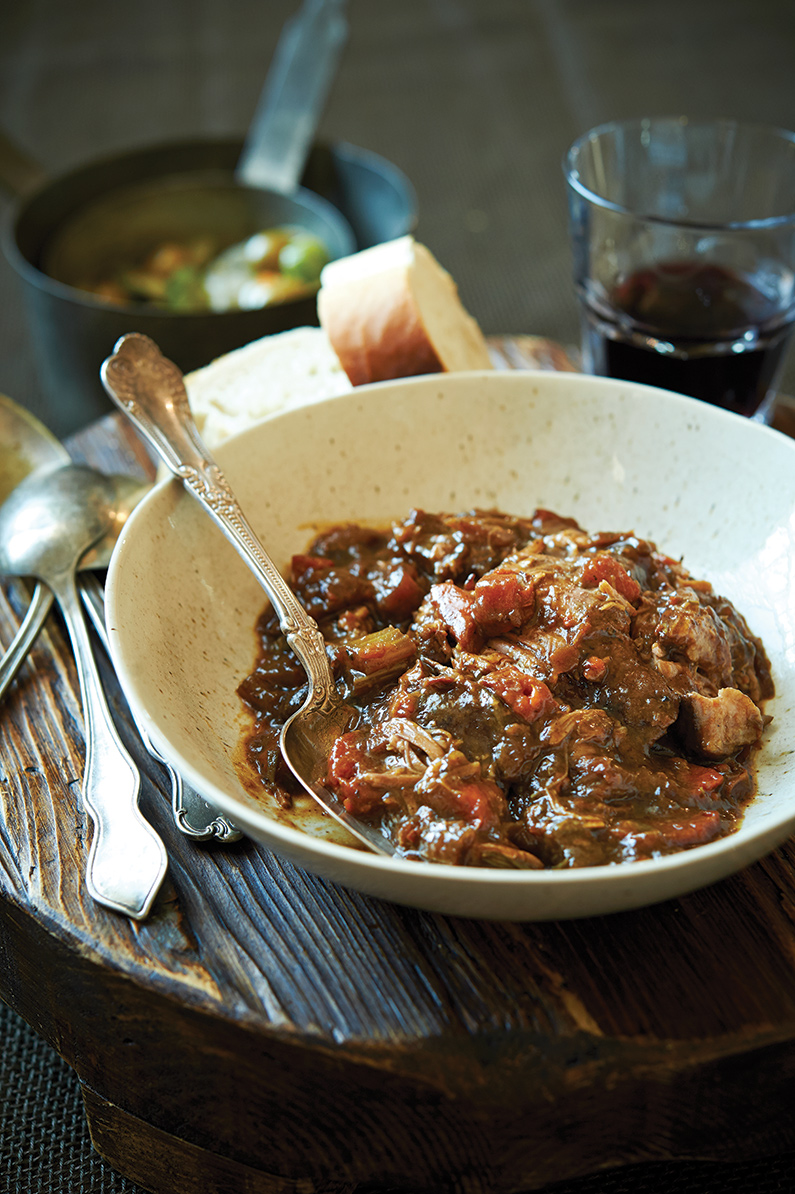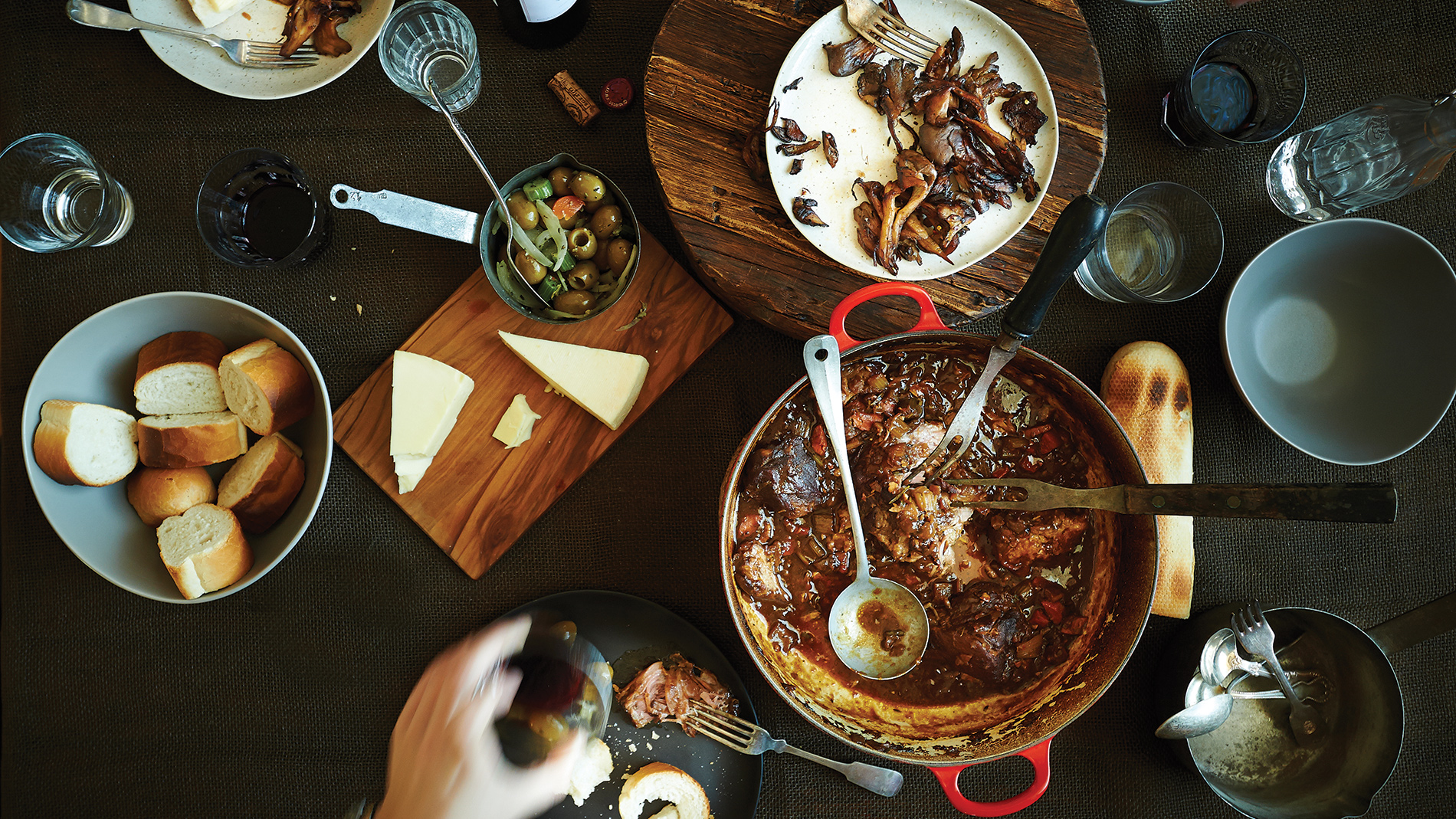Reviving 18th-century barbecue on the banks of the Mississippi
I started my adventure in French braising at 2 p.m. in the backyard, with 2 pounds of Boston butt pork shoulder, a 7-quart cast-iron Dutch oven, a bottle of Côtes du Rhône and fire.
Braising is a thing close to meditation. Like any method of slow-cooking, it takes hours. The technique lacks the machismo imputed by a wood smoker, which earns it little fanfare or popular appeal. (Seriously, how often do you see a line out the door at the newest braising joint?) But even if it has eluded the attention of the trend-conscious, the slow braise can be a joyous ritual for those willing to try it. After all, anyone can throw a few pork steaks on a grill, brush on a layer of sauce, and call it barbecue.
To my mind, real St. Louis-style barbecue is more complicated and more artful, stretching back to the city’s days as a little trading post perched on a steep bluff along the western shore of the Mississippi. The fledgling crossroads town at the confluence of the two major North American waterways served as the supply line for boisterous pioneer feasts and annual trading rendezvous where trappers, merchants, American Indians and mountain men took to gambling, dancing, heavy drinking and serious eating. Much to the delight of French voyageurs (mainly fur trappers), feast days were celebrated with rich, hearty meals slow-cooked over warm embers. Thick stews and wine-drenched braised pork were heaven on earth for those travelers, whose bland diet on board their canoes consisted mainly of corn mush and pemmican, a calorie-dense brick of dried, ground meat, berries and rendered fat.
Along with pork, Europeans introduced cast-iron cookware to the lower Missouri basin. Nestled over a fire or buried with red-hot coals, these kitchenware workhorses incorporated the Old World style of cooking with the New. Taken from the French word for “hot charcoals” or “warm embers,” braiser was one such technique, involving searing and browning cuts of meat and accompanying vegetables at a high temperature, then slowly simmering them in any combination of liquids – fat, stock, wine, beer or water.
My mouth watering, this is how I found myself resurrecting 18th-century-style St. Louis barbecue at lunchtime on a Saturday. I had just introduced my new Dutch oven to a red-hot pile of coals on an outdoor grill. My objective was a barbecue braised pork shoulder (a la voyageur), a rich and savory meal tailor-made for dinner parties.
While not as daunting as, say, making consommé or even the humble baguette, I was forced to admit I was, by voyageur standards, a braising greenhorn. To gain more insight on modern renditions of the technique, I touched base with a handful of area chefs. Mathieu Lefebvre, executive sous chef of the Saint Louis Club, assured me there was no reason to be intimidated – just take my time.
“It’s not complicated and can be a great way to have an afternoon of cooking,” he said. “Depending on the size and the cut of meat, the braising is something that will usually take three to four hours to make sure it’s fully moist and full of flavor.”

Chef Carl McConnell, who co-owns Cottleville’s Stone Soup Cottage with his wife, Nancy, has adopted a similar laissez faire attitude. “Have patience,” he said. “It’s definitely not a dish that can be rushed.”
Encouraged, I dove right in and made my first attempt at braised pork shoulder, which emerged from the pot as dry as the French Languedoc. The lesson? Regardless of how long the simmering phase seems, marinating the meat beforehand is essential for achieving a more robust taste and color. For instance, when Lefebvre preps a beef bourguignon, he’ll soak the meat and vegetables in red wine at least two days in advance to enhance the flavor.
Maintaining the amount of liquid in the braise is another stumbling block. McConnell checks his pot periodically, every now and then tasting and poking the meat with a fork to determine its texture, being careful not to over-braise it or let it dry out.
Another key factor in a good braise is the heat source. More than just an excuse to sit outside and sip wine, cooking over the fiery coals offered the best of both worlds: seared meat touched by the smoky fingers of an open flame, then slow, steady heat to add moisture during the simmer. When making his osso buco, McConnell starts off by lightly smoking the meat before braising it in pinot noir and veal stock. He cooks slow and low, carefully manipulating the flames. “The tricky part, especially when using an open fire, is keeping the coals stoked to where they’ll maintain a constant temperature of around 300 degrees,” he said.
With any open-flame cooking, there’s a definite risk of scorching the meal, said Eddie Neill, co-owner of Café Provencal. What first-timers need, he said, is an empty vessel on hand in case they burn the meat. If so, they can immediately pull it, arrest the cooking, get the Dutch oven clean and start over. The dish is easily salvaged by cutting off any bad sections and then reintroducing it to new stock or liquid.
To draw out the best tastes in his braising dishes, McConnell cooks the day before, letting the pot sit refrigerated overnight and reheating an hour or so prior to service. Before popping it in the fridge, he prepares a sauce by clarifying a portion of the braising liquid, straining it through a coffee filter and chilling it overnight to remove any excess fat. The next day, he’ll reheat the dish and thicken the sauce using cornstarch and water, or make a roux with flour and butter. On my second try, I took McConnell’s advice and finished the braise with flour and butter. Redemption!
Classic and hearty braising dishes are especially ideal for small dinner parties. “You don’t want to be chained to the kitchen all night long,” McConnell said. “If you offer a braised item, it’s something that can be simply reheated and thrown in the oven as your guests arrive, and it’ll be ready to serve without you having to really do anything.” Neill, too, swears by the ease of serving the dish once the advance prep work is done. He also can’t help but be entranced by what he calls the “voilà moment.”
“The old-fashioned Dutch ovens have this heavy gauge and a really neat look to them,” Neill said. “The lid is finally lifted off and you have that great initial smell. You have crusty pieces of French bread and some beautiful wine. And there’s just this wonderful communal aspect of a host pulling off pieces of meat and vegetables and ladling a little extra sauce on there. It really adds to the romance of what is really just very simple food.”
Get our recipe for barbecue-braised pork shoulder here.
Tags : Recipes






